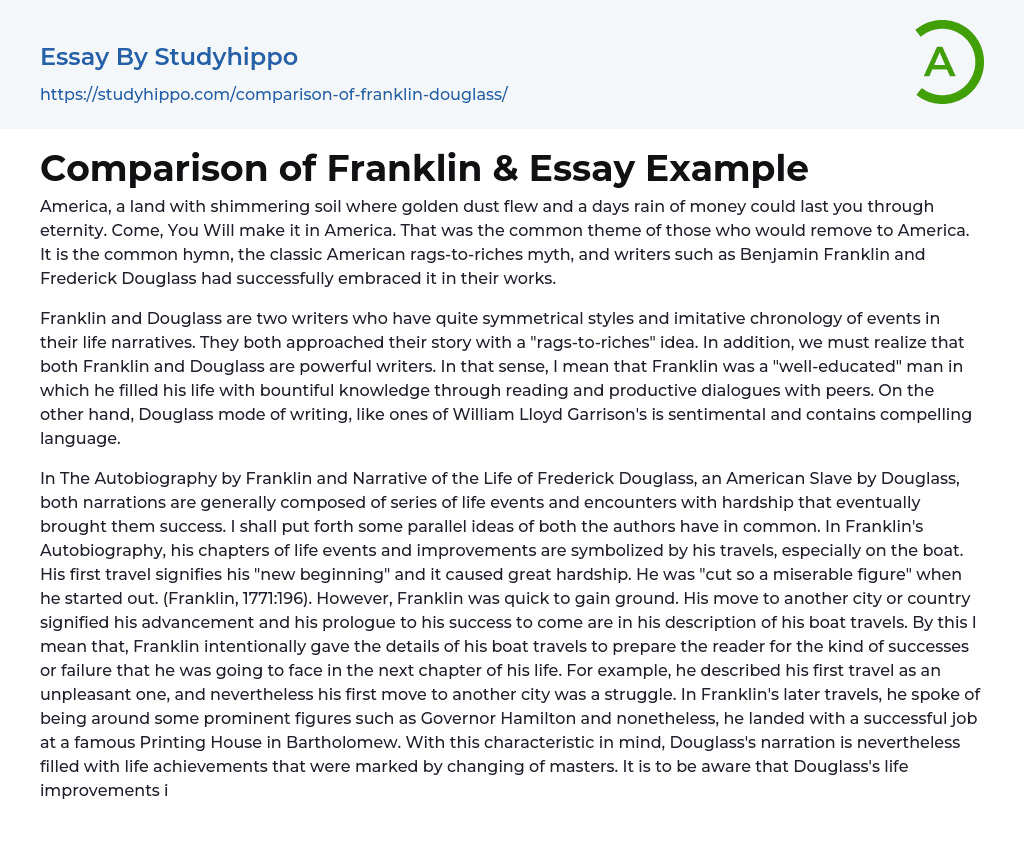In America, a country with bright soil that sparkles and where money falls like rain, people believe that anyone can succeed. This belief is shared by those who choose to move to America. It is a popular idea, the well-known myth of going from poverty to wealth, and authors like Benjamin Franklin and Frederick Douglass have effectively portrayed this concept in their writings.
Both Franklin and Douglass have similar writing styles and chronology in their life narratives. They both embrace the "rags-to-riches" concept and are powerful writers. Franklin, being well-educated, acquired knowledge through reading and engaging in productive dialogues. On the other hand, Douglass's writing resembles that of William Lloyd Garrison's, utilizing sentimental language that captivates readers. In both Franklin's Autobiography and Douglass's Narrative of the Life of Frederick Douglass, an American Slave, both authors
...recount a series of life events and hardships that eventually lead to their success. Franklin symbolizes his progress and improvements through his travels, particularly on a boat. Despite the initial hardships he faced, Franklin quickly gained ground and saw his moves to different cities or countries as a sign of advancement towards future success, which he describes in the prologue of his boat travels.The text describes how Franklin intentionally shared details of his boat travels to prepare the reader for the upcoming successes or failures in his life. Despite his first travel being unpleasant, Franklin's move to another city was a struggle. In later travels, he encountered prominent figures like Governor Hamilton but ultimately found success at a famous Printing House in Bartholomew. Similarly, Douglass's life achievements were marked by changing masters, although it is important to note that these improvements
were not directly related to how his masters treated him. For example, he gained literacy while belonging to Mr. Auld, made new friends with the Hughs, and developed consciousness and courage while with Mr. Covey, a slave breaker. These assets gradually became his means of escaping slavery. Another similarity between the two narrations is the creation of characters by the authors themselves. The chronology and events in both authors' lives are questioned.Both authors, Franklin and Douglass, carefully selected events in their autobiographical works to emphasize the specific characters they wanted to portray. Although both narratives are based on their own lives, they exaggerated their roles in order to establish themselves as impoverished and disadvantaged individuals at the beginning, gradually ascending to power and success. Franklin, for instance, depicted himself as dirty and burdened with shirts and stockings, eating one while carrying another, to provide readers with a vivid sense of his condition when he ran away. Similarly, Douglass employed a similar approach to highlight his destitution. Douglass consistently emphasized his "sufferings," despite experiencing relatively less physical abuse compared to other slaves, while rarely glorifying his stroke of luck in receiving comparatively better treatment from most of his masters. The intentional exaggeration of characters by both authors primarily serves as a platform for embedding the rags-to-riches myth within their narratives. This style proves particularly effective as it taps into the American myth subliminally woven into their stories, which resonates with American readers and encourages them to buy into the authors' ideas.This style is widely used by other writers, especially anti-slavery writers, because it is a convenient way to compose sentimental approaches. Writers like Jacobs, whose works
primarily aim to inspire readers to take a stance against slavery, commonly use this style. I have previously mentioned that both Franklin and Douglass started out poor and unable to resist oppression. However, at 17 years old, they found the courage to break free and achieved success in their lives. The similarity in age during their turning points holds some significance in the story and for the authors, indicating that both agreed that 17 is the age of maturity. Furthermore, both authors believe that persuading matured readers is generally more challenging compared to younger readers aged 16 to 18. This is why Franklin and Douglass intentionally set their rebellious stage at the age of 17. They aimed to encourage teenage readers who are more "unstable" to dare to do something different and not conform to normality. This inherent instability enables these teenagers to be more receptive to radical ideas. Bearing this in mind and leveraging the vulnerability of Americans in believing the rags-to-riches myth, Franklin and Douglass were able to create effective and persuasive narratives. With their skill in writing prose, they crafted well-structured compositions that followed the chronology of the "rags-to-riches" storyline.The myths that Americans live by are what make up the American Dream, which ultimately keeps the country thriving (Douglas 1845:p.1017-1081, Franklin 1776:p.282-284).
- American Literature essays
- Between The World and Me essays
- Book Report essays
- Book Review essays
- Book Summary essays
- Books essays
- Character essays
- Coming of Age essays
- Dante's Inferno essays
- Everyday Use essays
- Flowers for Algernon essays
- Genre essays
- Greek Mythology essays
- Incidents in The Life of a Slave Girl essays
- Letter essays
- Literary Criticism essays
- Literary devices essays
- Literature Review essays
- Metaphor essays
- Myth essays
- Play essays
- Plot essays
- Poem essays
- Poetry Analysis essays
- Protagonist essays
- Reader essays
- Reason essays
- Rhetoric essays
- Rhetorical Question essays
- Rhyme essays
- Simile essays
- Tragic Hero essays
- Translation essays
- Understanding essays
- Utopia essays
- Villain essays
- Writer essays
- Abolitionism essays
- Adam Smith essays
- American History essays
- American Revolution essays
- Ancient Egypt essays
- Articles Of Confederation essays
- Atlantic Slave Trade essays
- Aztec essays
- Benjamin Franklin essays
- Civil Rights Act of 1964 essays
- Civil Rights Movement essays
- Civil war essays
- Cleopatra essays




